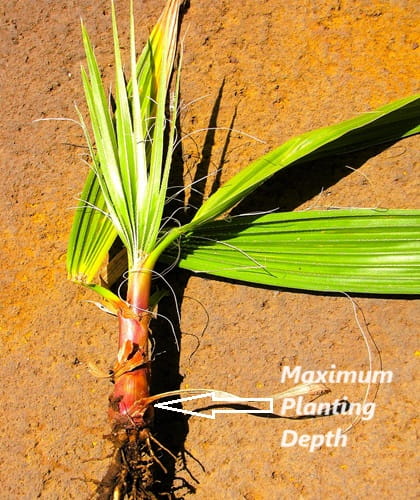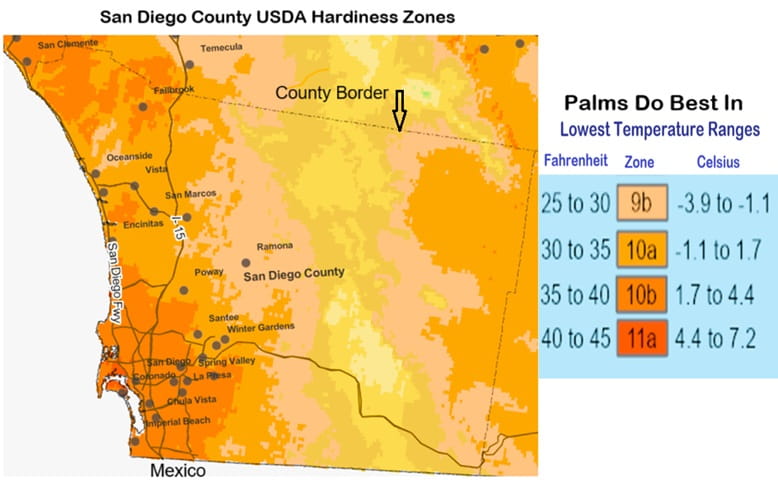- Home
- Palm Tree Problems
- Visible Palm Roots
Palm Tree Roots Exposed
Problem? Or Not!
Did you notice palm tree roots exposed? Maybe it's your own palm tree. Or you saw this happening on palms in a city landscape or park.
Does it make you Wonder If It's Natural? Is it just part of palms' normal growing process?
Or then, maybe there's a Problem With That Palm? Perhaps it's your palm, so you're a little worried. Is this palm tree root exposure a sign of a cry for help?
Let's delve into the "underworld" WHY of Palm Tree Roots and explore these questions.
At Mission: Palm Trees
Palm lovers can soothe their palm-related searches and concerns. Our articles are intended to inform, while having fun, easily Finding What You Want or Need. Without unneeded shoptalk & tiring endless research. We Research For You!
Why Are Palm Tree Roots Exposed?
Why are palm tree roots visible in the first place? Does it Need To Be fixed?
The primary reason for this are traits related to their specialized Palm Growth Habit. Palms have their own way of growing a root system.
 Oh, right!
Oh, right!The palm tree roots exposed don't exactly look like this. 😏
The characteristic palm tree root structure is different from typical tree species.
Palms have a root initiation zone formed at the base of the trunk. Which is where roots begin growing after a seedling's establishment.
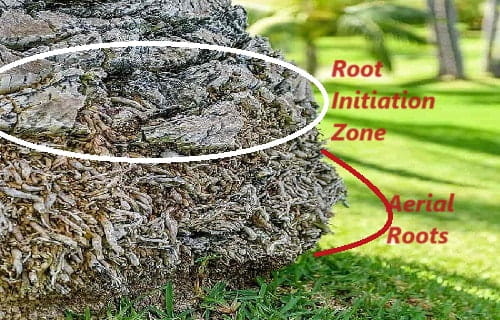 Aerial Roots Come Out From the Root Initiation Zone.
Aerial Roots Come Out From the Root Initiation Zone.Now That's More Like It! 🤗
Roots spread out under the palm canopy, to as much as 50' (15m) from the trunk.
Palm roots primarily grow horizontally below the soil's surface. Most palm tree roots are within 6in/15cm) of the ground's surface. Contrary to typically deeper roots of woodland trees.
 If You Had X-Ray Vision to See Underground.
If You Had X-Ray Vision to See Underground.For How Palm Roots Grow
Palm Roots Exposed Normally
For palm lovers, it's fascinating to learn about the roots of palms! There are several ways that palms expose their roots in a normal fashion.
Although the sight of your own beloved palm tree's roots emerging above ground might appear concerning, take a sigh of relief. For some palm species visible roots are completely normal. Not a cause for concern. They're just going about growth in their unique way!
Palm's Stilt Roots
In some palm species, the root initiation zone goes way above ground level. In their native tropics you may see palms with roots growing from up to ten feet above the soil.
These specialized roots are also called Prop Roots. These support roots ring the trunk. Sometimes producing Spine Roots along the surface. One species with palm tree roots exposed this way (including growth of Spine Roots) Is Socratea exorrhiza.
Aerial Roots on Palms
Other species you may have noticed have a stubby root system visibly growing out, beneath the trunk's lowest portion.
It almost looks like the roots are pushing the trunk upwards! They sort-of are, from growing adventitious roots out of the root initiation zone. Some species do that. Others create these exposed roots in response to inconsistent water access.
But it's just a normal growth function of some palms. For instance the Phoenix genera palms do this.
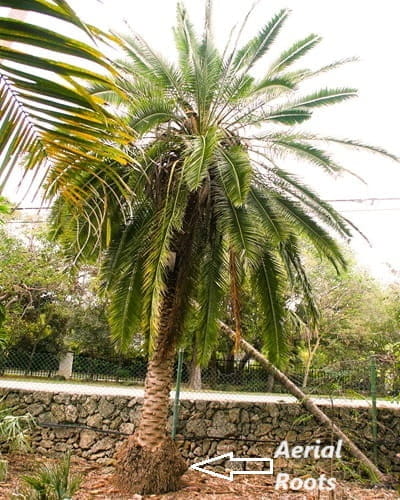 Phoenix reclinata adventitious aerial roots.
Phoenix reclinata adventitious aerial roots.David J Stang - CC BY-SA 4.0
Summing Up Palm Tree Roots Exposed Normally
Abnormally Exposed Palm Roots
Situations occur where palm tree roots are exposed from some sort of Palm Tree Problem. Take a look at what can happen:
SOIL PROBLEMS
Roots could become exposed due to soil erosion. Heavy rains, abrupt water flow, or improper landscaping can cause soil erosion.
Most roots of palm species are meant to be underground. Having that proper depth where they enjoy protection, better nutrient access, and the palm is solidified in the ground.
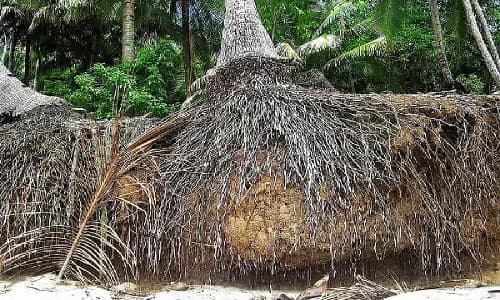 This Coconut Palm Had Inadequate Support
This Coconut Palm Had Inadequate SupportBecause of Sandy Soil Erosion. Ended Up Toppling Over
IMPROPER SEED PLANTING
If you're thinking of Growing a Palm From Seed, it's important to know how much soil should cover over it.
Most species' seeds barely need any earth covering above. It's all about knowing the growth details of the palm you're going to plant.
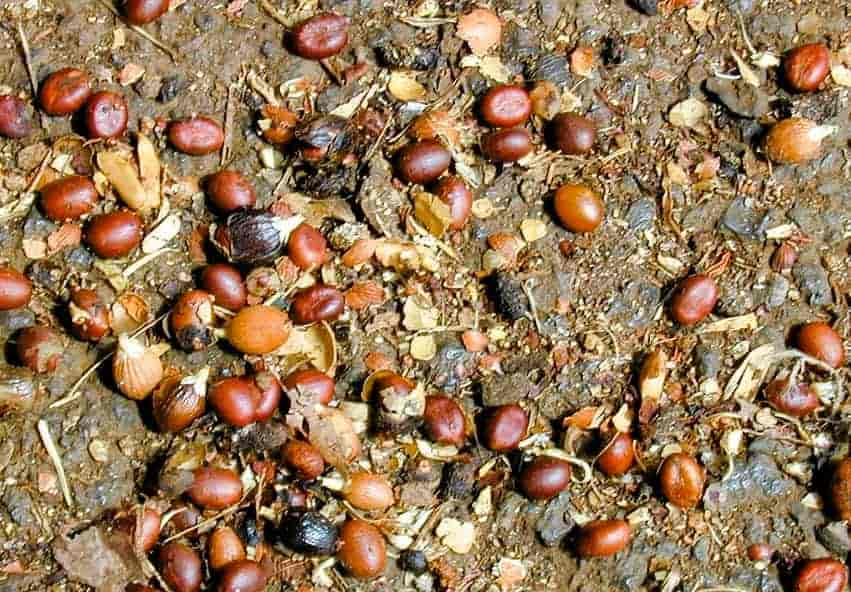 Washingtonia robusta seeds on ground. About 1/2in/1.27cm long
Washingtonia robusta seeds on ground. About 1/2in/1.27cm longEasy to Grow From Seed - None to slight layer of soil on it. Some here are beginning to germinate!
Photo: Forest & Kim Starr - CC BY 4.0
ABNORMAL TRANSPLANTING DEPTH
Palm species need earth to be at the correct level for trunks. When a seedling palm is transplanted, it's essential for them to be at the proper soil level.
- If planted too deeply, they won't get enough needed oxygen.
- Planting too shallowly can cause existing roots to dry out, with little to no new root growth. And they won't have good anchoring support.
A change in pre-transplant depth of the trunk can eventually lead to roots becoming exposed. When correctly transplanted, your palm tree roots will stay underground. Where they belong! If that's the design of that species (most are like that).
Newest Palm Article
-
San Diego palm trees: History, Species, and Their SoCal Charm
Fascinated by San Diego palm trees? Discover their history, types, and why they're a staple of SoCal’s SD neighborhood scenery to inspire your landscape design.
Solving Exposure of Palm Tree Roots
If you notice your palm roots are exposed, it's worth investigating the cause.
Since even though it's normal for palm tree roots to be near the surface, abnormal root exposure isn't good. So, is there anything you can do if your palm tree roots are overexposed?
Yes, indeed!
SOLVE FOR EROSION & INAPPROPRIATE HIGH PLANTING
- Was your palm tree roots exposed because of soil erosion?
- Do you believe your palm shows signs of being planted too high in the soil?
Either way, it can definitely help to pile up soil around the palm's base. Surrounding the Root Initiation Zone.
If it's a young seedling, just cover the V-shaped stem area with 1" (2.5cm) of soil.
The soil addition around the palm base may camouflage exposed palm tree roots, while enriching nutrients available for roots' access.
 Image From CSC1950 - Attribution 4.0I nternational
Image From CSC1950 - Attribution 4.0I nternationalTakeaways for Palm Tree Roots Exposed
Reaching the end of our root journey, let's recap.
It's normal to see roots of some palms exposed. It's their structure & isn't a cause for concern.
But yes, soil erosion & planting errors can lead to excessive exposure. Be informed, be strategic in knowing your palm, and if in doubt, we recommend professional help.
Remember, palms' unique root structure is just one of their remarkable features. With your newfound understanding of their roots, you'll enjoy its tropical beauty for many years to come.
